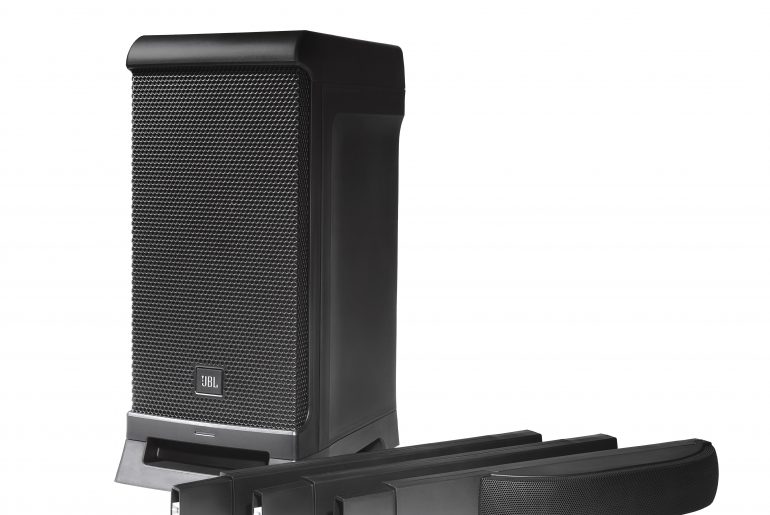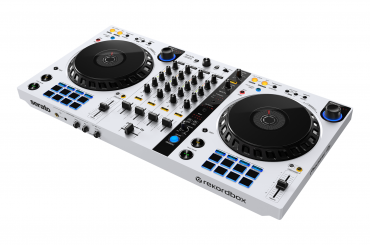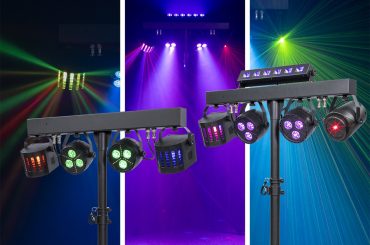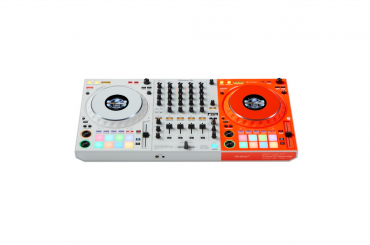This month’s Sounding Off entry offers two reviews. Boston-based DJ Paul Dailey takes on JBL Professional’s EON One Pro active, line-array PA system, while Denver-based DJ Wesley Bryant-King checks out Ultimate Ears’ 6 PRO custom in-ear monitors.
JBL EON One Pro
The EON series of powered speakers has been at the center of JBL Professional’s portable PA line for years, and the newest additions continue to keep their offerings top of mind for performers and DJs alike.
JBL’s EON One Pro ($1,874 MSRP) brings a new line-array option to the range, and the designers have brought to market an extremely useful product with many applications in mind.
Having spent a bit of time with RCF’s Evox 8 system, for example, I am familiar with the benefits (and limitations) of compact, linear, array setups. The positive, of course, starts with improved dispersion of sound, which in turn equals better room coverage with lower decibel levels – in easy-to-transport packages (this one weighs just 38 pounds). This is especially important in settings where music is part of the environment, as opposed to being the center of attention. It is within that nuanced situation where I see the EON One Pro performing extremely well.
First Impressions: Out of the box, the first thing that strikes you is that EON One Pro provides everything you need in a self-contained package. You get a 4-channel mixer (with selectable mic/line switch), monitor output, pass through, reverb and ability to play via Bluetooth while charging your USB device. And this all comes with a rechargeable battery capable of powering the unit for six hours. You can set up the unit in three configurations, based on how high you want sound to be projected, and the sound quality is what we have come to expect from the pros at JBL. It’s the very definition of working smarter, not harder.
Specifications: Reading the specs, you might be turned off initially. For example, the quoted maximum SPL is “only” 118 dB, which seems, and is, a low number compared to the figures that you see with more traditional active speakers (typically in excess of 128 dB).
But this sort of misses the point of the EON One Pro, as coverage angle is more important when thinking of compact arrays, and the distribution here is exceptional. People at the back of the room will hear your music clearly and those standing in front of the speaker will not have to yell to carry on a conversation.
Having said that, let’s be clear: This is not a loudspeaker that was built to drive a pounding set of electronic, bass-heavy music. In fact, there is no way I could honestly recommend this for your primary, big-party, DJ set-up – even for a night of older, less-demanding dance music. The 8-inch subwoofer adds a nice fill to round out your sound, but will not move a typical dancefloor.
No, this is a rig for acoustic musicians playing on a patio, or as a supplemental system for DJs looking to add sound for a ceremony far from a plug, or a cocktail hour where the music needs to be subtle, airy and play agreeably with the conversations in the room.
And as versatile mobile entertainers, we all need systems that sound good, look good and do these unique jobs well. For mobile jocks looking to fit the aforementioned applications, the JBL Professional EON One Pro should be near the top of their to-buy list.
Is now the time for DJs to go with IEMs? Ultimate Ears 6 PRO Custom In-Ear Monitors
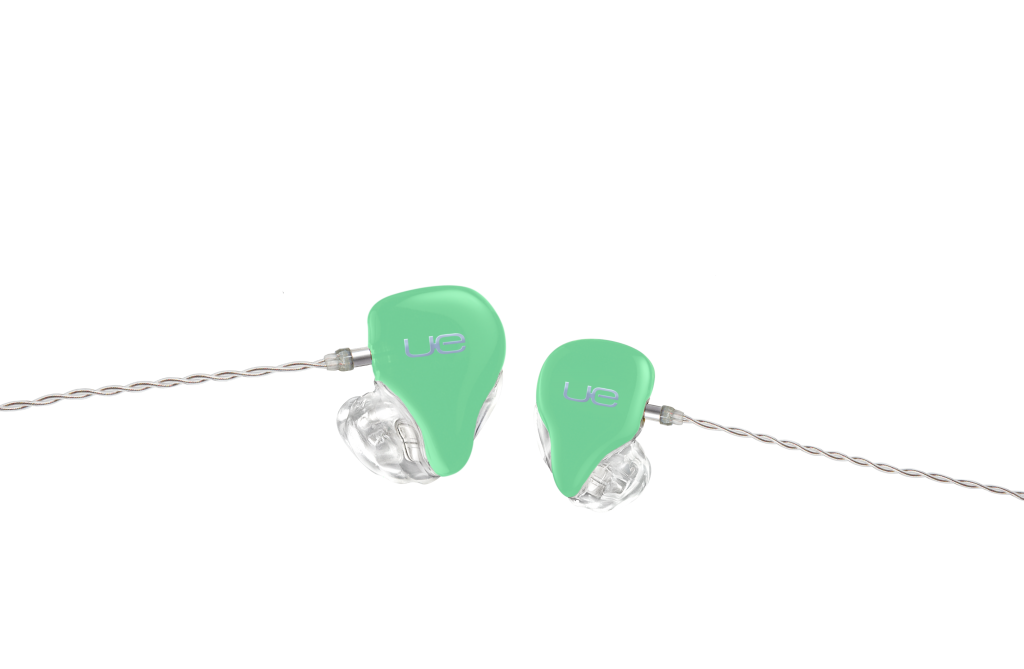
Ultimate Ears 6 PRO
It’s been awhile since I’ve written about custom in-ear monitors (CIEMs) for this magazine, but my level of passion about them hasn’t abated since my last review a little over two years ago.
My focus in that piece was on studio use of CIEMs; I’d reviewed Ultimate Ears’ so-called “Remastered” CIEMs at that point (now called simply UE Reference), and I appreciated their accuracy and their ability to let me work when conventional studio monitors might not be practical (say, when you’re trying to mix something in the middle of the night, and neither family nor neighbors would appreciate your thumping bass).
For those unfamiliar, in-ear monitors are, at the end of the day, essentially high-end ear buds. What separates an IEM from a simple ear bud, in my book, is the engineering that went into the product. A true IEM is designed to provide the sort of crisp, purpose-built sound quality that a musician or audio engineer needs in a stage or professional environment — the very applications that they’re typically made for.
A custom IEM takes that experience to a new level by packaging the IEM components in a shell that has been custom-shaped to fit the ear of a specific individual. A custom fit allows the IEM to very effectively provide passive noise reduction, which is essential for live stage use.
Of course, what works for a musician can work for audiophiles, too, and I have to confess that’s been my primary use for the past year of the company’s UE 18+ PRO CIEMs. I’ve been conducting an extended road test of sorts of the product, and while the UE Reference model is designed for flat, accurate reproduction, the UE 18+ PRO colors the sound a bit to provide a stronger low end. With six balanced armature drivers packed into each one that are divided into four frequency bands, I can say that the 18+ provides incredible sound — as one might expect given the roughly $1,500 per pair price point. I carry my pair of 18+ CIEMs with me everywhere I go, and given that I travel frequently, they’re in my ears once I’m past security all the way to when I get in a car at the other end of the trip.
Recently, Ultimate Ears refreshed their entire product line with a new approach to the audio cables they use, and the connection method between the cables and the CIEMs themselves. They refer to it as the “IPX Connection System,” and it represents the company’s third generation solution. Developed in conjunction with a company who has a market-leading offering for hearing aids and medical devices, the cabling is purported to be stronger, longer-lasting, and better able to withstand sweat, makeup, and all the other hazards of being an active performer.
The company also added a new product to the lineup: The UE 6 PRO ($699 a pair). Complementing the company’s new high-end UE Live offering ($2,200 a pair), which is targeted at touring musicians, the more modestly priced UE 6 PRO (like the UE Live) leverages a hybrid driver design that blends the company’s True Tone balanced armatures with a pair of neodymium dynamic drivers. While the spec sheet says that the low-end reach is the same as my UE 18+ PRO pair (frequency response is stated as 5 Hz to 22 kHz), the UE 6 PRO delivers a much more pronounced low-end. As such, it’s targeted for users performing rhythm and beats, including drummers and bass players. But I also believe it might be a turning point for DJs to consider going with CIEMs as well — and there are a number of reasons I say that.
First, let’s face it: The working environment for club (and many other) DJs is not exactly ideal for those who need to be able to hear for a living. A simple Google search for “DJs hearing loss” will reveal that this is a subject of growing concern. While I don’t do any club work these days, when I did, I actually wore high-resolution ear plugs (Etymotic ETY-Plugs, specifically) under my traditional can headphones. Even with the great care I’ve taken, I still suffer from a small amount of tinnitus (ringing in the ears) from loud sound exposure over the years, and generations younger than mine are experiencing hearing loss earlier than ever. The passive noise reduction afforded by properly fitting CIEMs seems like a smart measure to help avoid this particular occupational hazard.
Second, the UE 6 PRO provides enough low-end that beat-matching is easy, even at the modest volume levels you want to be using (again, to prevent hearing loss), and even where the house audio system might be registering thunderous low-end in the very soles of your feet. My method of testing the veracity of that statement was admittedly not in a club environment; I cranked up the bass (and the volume) with my studio’s monitor sub enabled and found the UE 6 PRO to still deliver what I needed to mix accurately. High-latency house sound systems and the proximity of the DJ booth to the subwoofers may cause your mileage to vary, but no more so, in my view, than other monitoring options.
Apparently, I’m not the only one to feel the enthusiasm; one New York area DJ who’s tried the UE 6 PRO units found he was able to hear the entire mix more clearly, and to perform his track blends with greater accuracy — all while experiencing less ear fatigue in the process.
The final reason in my book is this: Price. No CIEM is going to be “cheap,” per se, but the UE 6 PRO checks in at $699 a pair. In the grand scheme of CIEMs, that isn’t a bad price point, and is much more attractive than the $1,500 a pair UE 18+ PRO, which with their low end would serve DJs well, too.
Note that to order CIEMs, you need your ears either molded or scanned. The 3D digital scanning is available from select Ultimate Ears resellers, and traditional molds can be done by most audiologists at market rate (often under $100). Either option results in a great fit, and Ultimate Ears will make adjustments to fit under warranty in the event things aren’t 100-percent right for any reason. (Good peace of mind, and unfortunately, my UE 6 PROs did end up needing a tweak after the initial fit was a little too tight.)
The final question, however, remains one of style, rather than functionality. I started my DJ career in my own bedroom, so I got used to mixing with both cans over both ears, for the duration of my performance. That classic DJ pose of a single can over one ear that some people deem so essential to the DJ ethos just wasn’t for me. Whether wearing CIEMs instead of headphones suits your performance comes down to a matter of image, but for my two cents, I’ll take the CIEMs any day. (One of my contacts at UE has said that some CIEM-using DJs actually use non-connected can style headphones solely for looks, while the nearly invisible CIEMs are inserted. That’s a thought, too.)
As much as I love the new UE 6 PRO — and I do — my only issue is with the new cabling system. It’s a huge improvement to be sure; one of my older pairs of CIEMs suffered a break at a common stress point: the nub molded into the casing where the cable connector is located in the previous design. With the new IPX system, that nub is gone, the stress point is removed, and I’m guessing that’ll prove to be a salient design choice over time.
Unfortunately, that nub, along with a bendable around-the-ear element of the cables, was what made getting earlier UE CIEMs in and out of your ears so easy; you could use it as leverage to rotate the CIEM, and that’s also what made it a stress point (and point of failure). In the new system, that stiff, but bendable part of the cable is gone, so orienting each IEM for insertion, and getting them into your ears — while not rocket science — is not the sort of muscle-memory-automatic exercise it was in the previous design. With the nub gone, too, there’s no leverage to help rotate them back out. I have to really think about it every time I use them, and thus, they don’t go in or come out quite as fast as they used to. Regardless, I’ll accept that trade-off for the benefits provided by the new design.
My bottom line: Now may well be the time to seriously consider custom in-ear monitors if you’re a performing DJ. Between the functionality, price point, and performance, it’s an investment that makes sense both for the art of DJing — and for taking steps to protect your own hearing (and thus your career) over the long term. Information at: pro.ultimateears.com.


